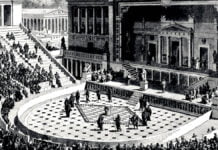The word chorus means a ‘group of dancers’ in Greek, and choral songs were performed in religious festivals in ancient Greece. The importance of the chorus in literature and performing arts lies in its ability to enhance storytelling, convey thematic depth, provide commentary, and engage the audience or reader on multiple levels. Whether as a group of characters in a play, a recurring motif in a poem, or a collective voice in a musical performance, the chorus is a vital and versatile element of artistic expression.
Evolution
In ancient Greek drama, the chorus played a central role. Composed of a group of masked actors who both commented on the action and interacted with the characters, the chorus served as a bridge between the audience and the events unfolding on stage. They provided background and summary information to help the audience follow the performance. They also expressed communal emotions and values aligned with the audience’s perspective and interpreted the action within the framework of the cultural and moral ethos of the time. The Greek chorus often communicated in song, dance, and recitation and served as a bridge between the audience and the actors.
During Elizabethan and Renaissance theatre, the use of a chorus decreased. Still, when present, it was typically a single person who served a role similar to that of a modern narrator. This individual provided the audience with exposition, setting the scene for the action to unfold and sometimes commenting on the themes or events of the play. Some Elizabethan plays, such as Gorboduc and Henry V, featured choruses who presented the epilogue and the prologue and provided commentary between the acts of the play. Many plays that do not have a chorus feature a choral character who participates in the action of the play only to a minor degree and who presents ironic commentary on the events in the play. The Fool in King Lear is an example.
In opera and ballet, the chorus is still commonly used. In opera, the chorus comments on the drama through music, while in ballet, the corps de ballet performs group dance parts that can enhance the story, setting, or mood.
The traditional Greek chorus is less common in contemporary theatre, but its influence persists. Now, although named differently (like the ensemble or the company), their role can be akin to a chorus, providing background support, transitioning scenes, and occasionally advancing the plot through song or action. Some modern plays and musicals have revived the use of the chorus as a deliberate stylistic choice to provide commentary. One notable instance of using chorus in 20th-century drama is T S Eliot’s verse play Murder in the Cathedral.
Literary Devices
In literature, the term chorus can refer to a recurring group of characters, voices, or motifs that serve a similar function to a musical chorus. For example, in epic poetry such as Homer’s Iliad or Odyssey, there are often recurring refrains or groups of characters who provide commentary or reflect the broader themes of the narrative. These literary choruses can add depth, symbolism, and thematic resonance to the text.
Community and Collective Voice
The chorus can represent a collective voice or community presence in performing arts such as theatre, dance, and music. Whether it’s a group of singers in a musical, a troupe of dancers in a ballet, or an ensemble cast in a play, the chorus often embodies a sense of unity and collective expression. This collective presence can enhance the storytelling, contrast individual characters, and convey broader social or cultural themes.
Narrative Structure and Framing
In some literary works, the chorus serves a structural or framing function, providing commentary or framing the narrative. For example, in Chaucer’s Canterbury Tales, the narrator serves as a chorus, guiding the reader through the various stories and offering commentary on the characters and events. Similarly, in modern literature, authors may use chorus-like devices to frame their narratives or provide meta-commentary on the story being told.
Symbolism and Allegory
The chorus can also function as a symbolic or allegorical element in literature and performing arts. It may represent larger themes or concepts beyond the immediate narrative as a metaphorical or symbolic presence. Through their words, actions, and interactions, the chorus can convey deeper layers of meaning and invite interpretation from the audience or reader.
The chorus concept can take on various meanings and roles in literature and performing arts depending on the specific medium and cultural context. Each type of chorus has its distinct features and functions, but all serve the essential purpose of collaboration in the storytelling process, offering additional layers of meaning, commentary, or aesthetic pleasure.





























